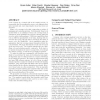Free Online Productivity Tools
i2Speak
i2Symbol
i2OCR
iTex2Img
iWeb2Print
iWeb2Shot
i2Type
iPdf2Split
iPdf2Merge
i2Bopomofo
i2Arabic
i2Style
i2Image
i2PDF
iLatex2Rtf
Sci2ools
ISSTA
2009
ACM
2009
ACM
Advanced code coverage analysis using substring holes
Code coverage is a common aid in the testing process. It is generally used for marking the source code segments that were executed and, more importantly, those that were not executed. Many code coverage tools exist, supporting a variety of languages and operating systems. Unfortunately, these tools provide little or no assistance when code coverage data is voluminous. Such quantities are typical of system tests and even for earlier testing phases. Drill-down capabilities that look at different granularities of the data, starting with directories and going through files to functions and lines of source code, are insufficient. Such capabilities make the assumption that the coverage issues themselves follow the code hierarchy. We argue that this is not the case for much of the uncovered code. Two notable examples are error handling code and platform-specific constructs. Both tend to be spread throughout the source in many files, even though the related coverage, or lack thereof, is h...
| Added | 28 May 2010 |
| Updated | 28 May 2010 |
| Type | Conference |
| Year | 2009 |
| Where | ISSTA |
| Authors | Yoram Adler, Eitan Farchi, Moshe Klausner, Dan Pelleg, Orna Raz, Moran Shochat, Shmuel Ur, Aviad Zlotnick |
Comments (0)

